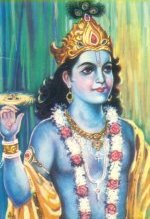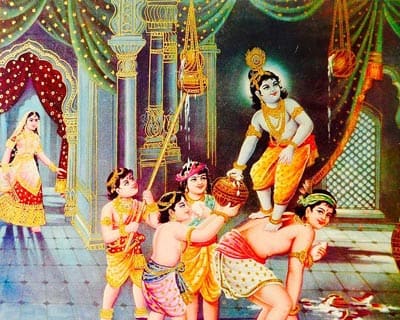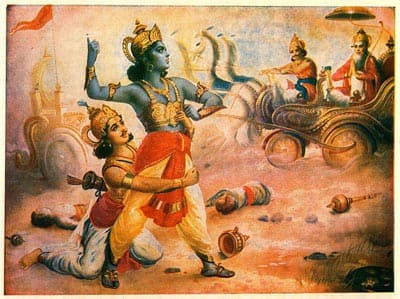Sri Krishna Biography

Sri Krishna said in the opening section of the Bhagavad Gita:
“Whenever, O descendant of Bharata, righteousness declines and unrighteousness prevails, I manifest Myself. For the protection of the righteous and the destruction of the wicked, and for the establishment of religion, I come into being from age to age.”
– Sri Krishna
Short bio of Sri Krishna
Sri Krishna was born in northern India in approximately 3,228 BCE. The Puranas consider Sri Krishna’s life to mark the passing of the Dvapara age into the Kali Yuga (current age)

However, even in his young years, Krishna is reported to have killed demons Trinavarta and Putana. He is also said to have lifted a nearby hill – Govardhana to protect the villagers against the wrath of Indra.
Sri Krishna in Brindavan
In the early stage of his life, Sri Krishna is also often depicted playing the flute for his beloved gopis – female devotees. Of these Radha was the greatest devotee.
This life episode was crucial in the development of Hindu Bhakti devotional tradition. It is this tradition of bhakti which was important in the lives of future avatars such as Sri Chaitanya and Ramakrishna. Sri Krishna taught that there were many paths to reach the goal of self-realisation, but devotion was the shortest path
“However men try to reach me, I return their love with my love; whatever path they may travel, it leads to me in the end.”
— Chapter 4, verse 11
Sri Krishna and Bhagavad Gita
On his return to Mathura, Sri Krishna killed his uncle Kansa – after Kansa had tried several times to have Krishna killed.
In Mathura, he befriended the Pandava Prince Arjuna. Sri Krishna became a counsel and friend to Arjuna.
The Kurukshetra war was a battle between the Pandavas and Kauravas (led by King Dhritarashtra). Despite the provocations of the Kauravas, Sri Krishna tried to mediate to avoid conflict. He asked the Kauravas to give the Pandavas just a small amount of land.
However, Dhritarashtra refused any compromise. Once war became inevitable, Sri Krishna offered a choice to his dearest friend Arjuna – either he could choose Sri Krishna himself, or he could choose Krishna’s armies. Arjuna chose the counsel of Sri Krishna rather than his armies.

“You are only entitled to the action, never to its fruits. Do not let the fruits of action be your motive, but do not attach yourself to nonaction.”
— Bhagavad Gita Chapter 2, Verse 47
During the battle, Sri Krishna occasionally intervened to help Arjuna and the Pandavas win. Sri Krishna broke his own word – proving his love for his dearest disciple was greater than so-called human morality.
Sri Krishna also unveiled his universal form to Arjuna – showing Arjuna his full spiritual Realisation. After this Arjuna became a disciple of Sri Krishna, rather than just admirer and friend. Sri Krishna embodied both the human and divine aspects. As an avatar, he played a human role, but, at the same time, was a fully realised soul – one with God. During his lifetime, few recognised Sri Krishna’s spiritual height.
Sri Krishna took eight principal wives and had many sons. However, his sons were unspiritual and became increasingly haughty and arrogant. It is also said, Sri Krishna took 16,100 more women whom he had rescued from Narakasura’s Palace after killing Narakasura. It illustrates Sri Krishna’s compassion for the downtrodden and unfortunate victims of society and old social traditions.
After the Battle of Kurukshetra, Krishna visited Gandhari to offer his condolences (Gandhari, wife of Dhritarashtra, had lost 100 sons in the battle) Gandhari cursed Sri Krishna because she believed he could have stopped the fighting. Gandhari cursed that Krishna would die within 36 years, along with anyone from the Yadu dynasty. Sri Krishna was happy to accept this curse because his sons had become badly behaved and he knew his mission was drawing to a close.
Sri Krishna at Dwarka
In later life, Sri Krishna retired to Dwarka where he lived for many years. Legend has it that Sri Krishna was killed by an arrow through his ankle when he was shot by a hunter, who mistook Sri Krishna for a deer. The ankle was the one area of weakness in Sri Krishna’s body. He accepted death calmly, knowing his time on earth and come to an end.
Citation: Pettinger, Tejvan. “Biography of Sri Krishna”, Oxford, UK. www.biographyonline.net – Published 12th Dec. 2016. Last updated 20 Feb 2020.
What was the importance of Sri Krishna’s life and mission?
Sri Aurobindo once said the four most significant events in world history included two events from the life of Krishna – exile of Krishan in Brindavan and his conversation with Arjuna on the field of Kurushetra. The other two were the siege of Troy and the life of Christ.
“There are four very great events in history, the siege of Troy, the life and crucifixion of Christ, the exile of Krishna in Brindavan and the colloquy with Arjuna on the field of Kurukshetra. The siege of Troy created Hellas, the exile in Brindavan created devotional religion (for before there was only meditation and worship), Christ from his cross humanised Europe, the colloquy at Kurukhetra will yet liberate humanity.”
Sri Aurobindo, On the Bhagavad Gita
Krishna’s play at Brindavan was a new development in spirituality. It allowed people to approach God through devotion to a personal aspect of God (in this case the divine form of Krishna. Previously spiritual practice had emphasised meditation and detachment. It broadened the appeal of yoga and religion into those whose temprement was devotional.
Krishna’s conversation with Arjuna on the battlefield of Kurukshetra. This immortal dialogue gave a clear and practical yoga for everyone to follow. It made the spiritual life accessible to all and removed the rituals and exclusivity of the old Vedic religion.
“Sri Krishna walked the soil to annihilate the philosophies of world-shunning spirituality and of world-grasping materialism. He established on earth the “Dharmarajya,” the Kingdom of the Inner Law. He restored the true spirit of Kshatriya heroism, motivated not by human ego, but by Divine Will, making man a devoted and active instrument of the Supreme. He brought down to the earth-consciousness the supreme Truth that earth and earthly life, being inherently divine, must be made outwardly divine, fully and totally, in every sphere, in every aspect.”
– Sri Chinmoy (Commentary on The Bhagavad Gita)
Krishna was a model king, husband, friend, spiritual teacher and avatar. Krishna had a profound impact on the culture, religion and spirituality of not just India but the whole world. His basic philosophy of yoga is the reference point for all future spiritual teachers. His play of devotional yoga was also the reference point and inspiration for all future Masters and saints who emphasize devotion – influential figures such as Mirabai, Sri Chaitanya and Sri Ramakrishna. Krishna’s teachings allowed a huge range and diversity of spiritual approaches – from the detachment and equanimity of the Gita, the intense devotion of the gopis. Thus Krishna imbued Indian spiritual and religion with a diversity, richness of spirit and thus tolerance for the many paths to the goal.
No comments:
Post a Comment